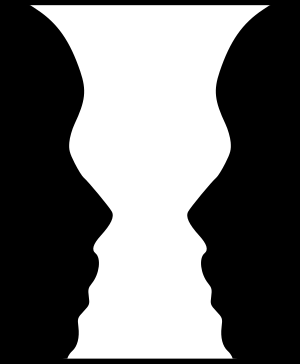Closure-Gestalt principle that explains how humans fill in visual gaps in order to perceive disconnected parts as a whole object.
For example:We see three incomplete circles, but we can figure out that the shapes create a triangle because we can fill in the gaps of the figure.
Continuity-Gestalt principle that states people have the tendency to group stimuli into continuous lines and patterns.
For example:We can group this flock of geese into a familiar shape or pattern, in this case this would be the shape of a V.
 Similarity-This is a rule of grouping humans that we use everyday unconsciously, this refers to the tendency for humans to group together objects or stimuli that seem similar to each other.
Similarity-This is a rule of grouping humans that we use everyday unconsciously, this refers to the tendency for humans to group together objects or stimuli that seem similar to each other.
For example:In this picture we can see two different groups, black squares and white squares, we will group the squares in different groups because they have distinct different appearances.
 Proximity-This means closeness, in terms of physical distance, personal relationship, or length of time. The principle shows that individuals are more likely to form social relationships with people who are close in proximity.
Proximity-This means closeness, in terms of physical distance, personal relationship, or length of time. The principle shows that individuals are more likely to form social relationships with people who are close in proximity.
For example:Proximity can mean many things, from relationships to length of time, in this case the two people are more likely to form a social relationship with each other as opposed to someone that lives in another city.
 Figure-Ground Perception- A type of perceptual grouping which is a vital necessity for recognizing objects through vision, and identifying objects from the background.
Figure-Ground Perception- A type of perceptual grouping which is a vital necessity for recognizing objects through vision, and identifying objects from the background.
For example:We can use this to find out an object from the background, if we look at just the white portion of the picture we see a vase like object, but if we look at the black portion we can see that the background forms two similar faces.
 Perception of Movement(Stroboscopic motion)-This the illusion of motion that occurs when a stationary object is first seen briefly in one location and, following a short interval, seen in another location.
Perception of Movement(Stroboscopic motion)-This the illusion of motion that occurs when a stationary object is first seen briefly in one location and, following a short interval, seen in another location.
For example:In this image if you stare at one portion of the picture and shift your eyes away and then back to a different part of the image you will see the image move in other areas not just one single area.
 Phi Phenomenon-Motion perceived by a subject, especially the illusion of movement produced when stationary stimuli, like pictures or lights, are presented in rapid succession and are sometimes in slightly different positions.
Phi Phenomenon-Motion perceived by a subject, especially the illusion of movement produced when stationary stimuli, like pictures or lights, are presented in rapid succession and are sometimes in slightly different positions.
For example:In this image we can see the plane propellers are moving very fast but the propellers are moving so quick that we can see another portion where it appears that the propellers are moving much slower than they actually are.
 Reversible Figures-An ambiguous 2 dimensional drawing that represents a three dimensional object in such a way that it can be seen from two different perspectives.
Reversible Figures-An ambiguous 2 dimensional drawing that represents a three dimensional object in such a way that it can be seen from two different perspectives.
For example:In this image is it clearly a 2 dimensional cube but i'ts an ambiguous figure. Some can see the the bottom of the cube and some can see the top, this is due to the multiple perspectives of the figure.
















